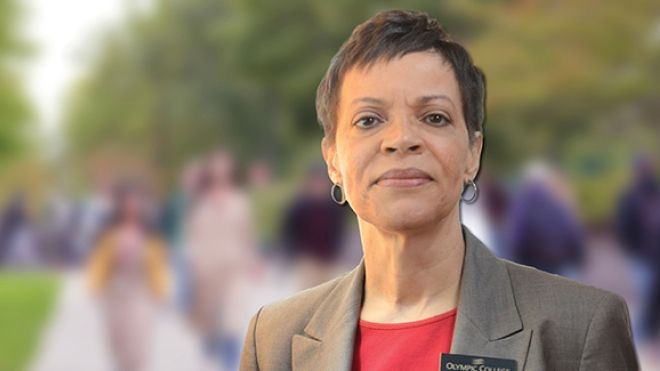New campus artwork by Coast Salish sculptor inspires “enlightenment”
If you’ve walked past the Bremer Student Center lately, you may have noticed a new piece of art designed to inspire and delight those who view it. “Messengers – Paths to Enlightenment,” a sculpture by Coast Salish artist Susan Point, is based on the symbolism of the butterfly and the hummingbird.
“For Coast Salish People, butterflies represent change and balance,” said Point, a celebrated First Nations Musqueam artist based in Vancouver, British Columbia. “Hummingbirds symbolize beauty, intelligence and love. Their ability to hover back and forth at high speeds is believed to guide people on a journey.”
The sculpture joins Lushootseed Language Markers installed on the Bremerton campus in May as artwork that honors the Indigenous People of this region.
Point was commissioned to create “Messengers” for Olympic College as part of the Washington State Arts Commission’s Art in Public Places program. The arts commission curates a public art collection of more than 5,000 works on state-owned properties including colleges, universities and public agencies. Funding for the art comes from half-of-one-percent of each new state construction project’s budget. Money for “Messengers” came primarily from Olympic College’s College Instruction Center, opened in 2018.
Local input on the art
A committee of nine people affiliated with the college reviewed the work of more than 80 artists before selecting Point for the commission. Art Professor Marie Weichman, a committee member, was “thrilled.”
“Susan Point’s work expresses everything we hoped to communicate to the public with our selection,” Weichman said. “First and foremost was the acknowledgement of the land’s history and its people. As an educational institution that serves our community, it was important to us that the origins and history of our area were reflected in the artwork and the artist chosen.”
The committee worked with Point on concept designs, aiming for art that would “inspire and empower those who experience it,” Weichman said.
The Coast Salish connection
Valarie St. Pierre-Hodge, a leader of the Native American and Indigenous Student Club, also finds the choice of a Coast Salish artist gratifying and appropriate. St. Pierre-Hodge, who is Apsa'alooke from the Crow tribe, was instrumental in bringing the Lushootseed Language Markers to campus. She also helped craft the college’s Land Acknowledgement statement, which honors the Coast Salish people — the Suquamish, Duwamish, Squaxin Island, and Skokomish — whose ancestral lands are occupied by Olympic College campuses.
The Lushootseed Markers, honoring the “Language of the Land,” represent the collaboration of many people from diverse groups across campus, said St. Pierre-Hodge. She hopes for more cultural connection opportunities.
“We want to continue to do that, make these relationships with these different departments to bring this community together,” she said. “Because until we come together, we can’t heal together.”
St. Pierre-Hodge sees that message carried forward with Point’s sculpture, to which her first reaction was, “’Wow, and so this story continues. And so, the message continues,’” she said. “I did tear up a little bit because it reinforces the message.”
Sculpture finds central location
“Messengers” was completed in 2021 on a budget of $146,300, which covered the artist’s commission, as well as transportation, installation of the piece and other associated costs.
A small portion of the budget came from a recently completed sewer and stormwater renovation within the central area of campus that will have a positive impact on the environment (and college plumbing), said Jennifer Gemmill, capital projects manager.
Originally slated for the College Instruction Center, “Messengers” ultimately was placed by the student center in a highly visible, high traffic site. The area around the sculpture will be landscaped with plants that attract butterflies and hummingbirds. Gemmill said.


